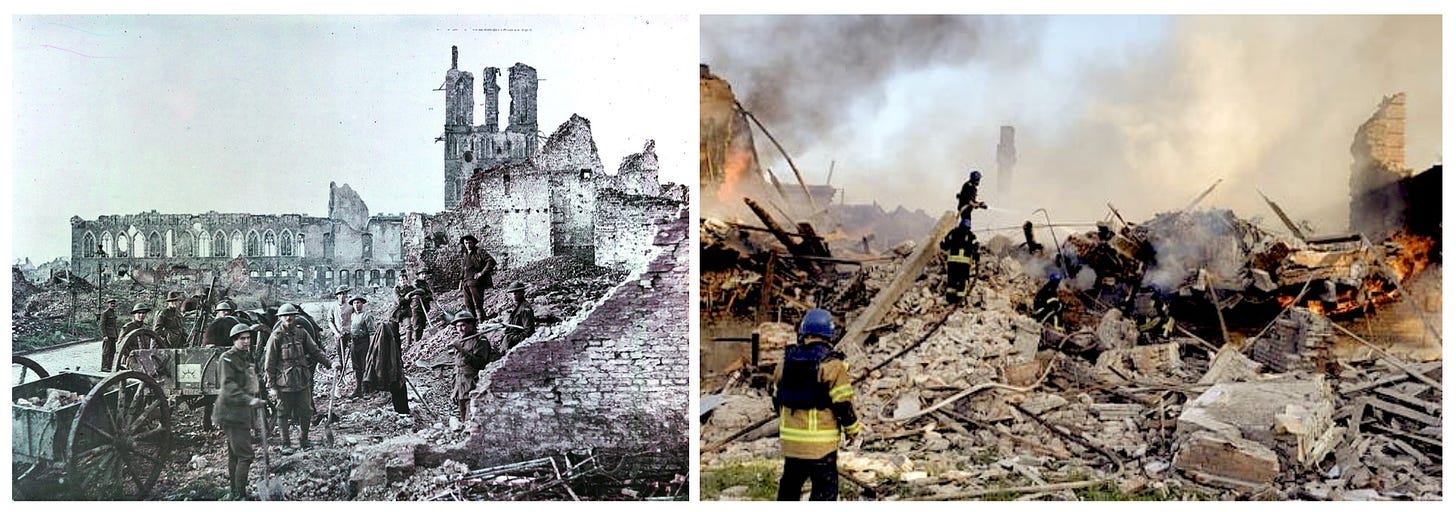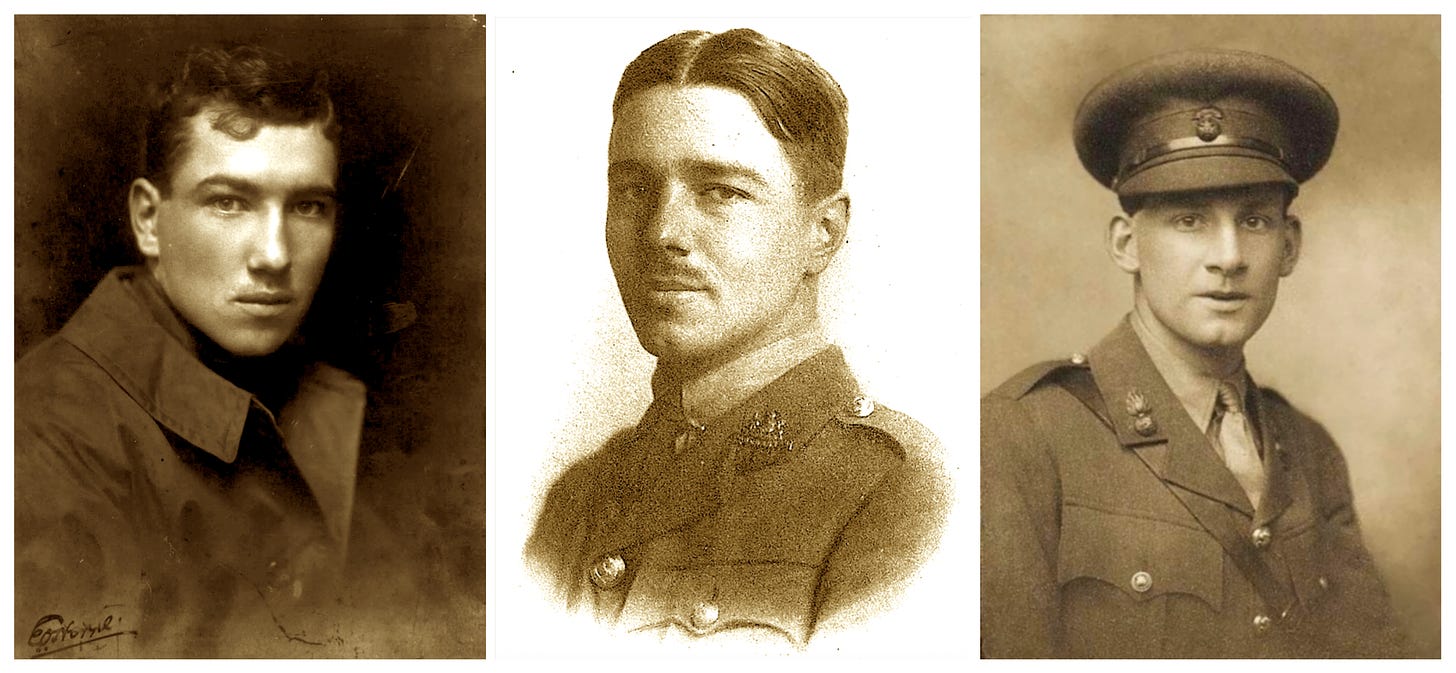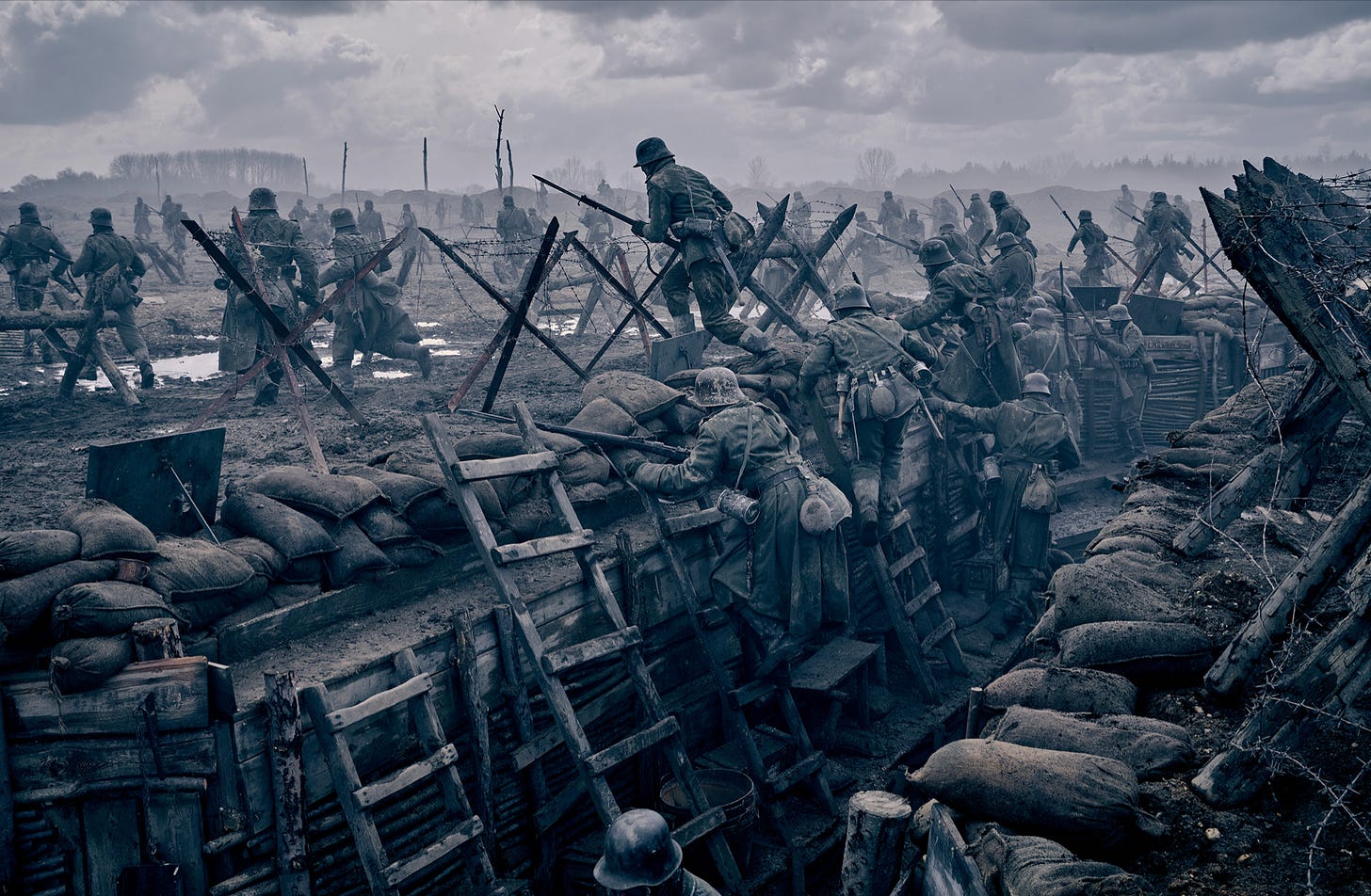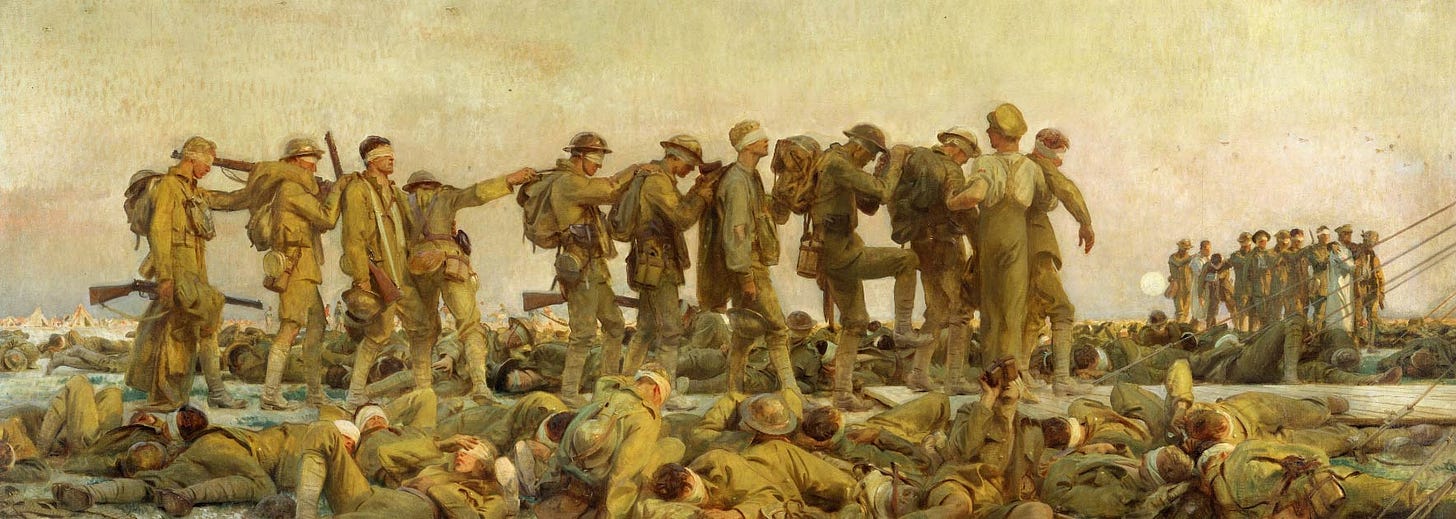Curtained with Fire: World War I, a Century On
As winter war convulses Europe, the past and the present are in stark alignment
Edited by David Swanson
There’s a land war going on in Europe—millions of soldiers, mostly men young and old, and tens of millions of civilians caught up in the struggle… Life and land, ancient cities, great stores of knowledge being poured down the open maw of empire on the march, while men curse the freeze and curse the thaw for the mud it makes, and die by the thousands and tens of thousands.
Sometimes a tickle hits your neck and it’s a wind out of history stirring your hair, some ghost passing you in the corridor; we’re just a few years past the centenary of Armistice Day, the peace that was supposed to be the final one. A generation of boys had vanished down the gullet of war then, a war led by men of the nineteenth century and killed with the guns and bombs and flamethrowers of the twentieth. It was supposed to have taught Europe a lesson.
Or so thought the war correspondent Phillip Gibbs, whose book Now It Can Be Told, published in 1920, he hoped would inspire “some new system of relationship between one people and another, some new code of international morality, preventing or at least postponing another massacre of youth like that five years' sacrifice of boys of which I was a witness.” (That Gibbs—despite his fears of another war—believed the Great War unique is most poignantly summed in his chronicle of French chateaux used as troop billets: “For many years to come, perhaps for centuries, those cottages and barns into which our men crowded will retain signs and memories of that British occupation in the great war. Boys who afterward went forward to the fighting-fields and stepped across the line to the world of ghosts carved their names on wooden beams...”)
The World War I memoir, and its cousin the roman á clef, form their own subgenre of twentieth-century literature. For obvious reasons most came out in the 1920s or early ‘30s; thus, while visceral and poignant, they inadvertently add to their own poignancy by our historical foreknowledge. This war of sabers and machine guns—the engulfing of one century by another, the old world violently consumed by the new—pulls at the consciousness of those observing another war at the beginning of another century, where twentieth-century military hardware faces off against twenty-first century technology.
Some writers of the First World War, like Gibbs, observe military life at close quarters while maintaining an address to posterity, damning “the grisly game” of war. Those who lived the lives of soldiers tend to write with the claustrophobic atmosphere of the trench: In Good-Bye to All That, poet and novelist Robert Graves’ account of an upper-class English boyhood that ended in the trenches of the Somme, acid-tongued assessments of fellow-soldiers from private to general are interspersed with laconic accounts of horror. The trenches, we are told, “stank with a gas-blood-lyddite-latrine smell.” Cornflowers abut trenches and slag-heaps; the first corpse he sees in France, and the very last, are soldiers who have committed suicide.
Perhaps the most haunting part of the memoir is Graves’ deadpan accounting of his teenage years, in a posh public school; nearly every friend or foe he encounters during that period goes on to die in the war, in France or Belgium or in the air above them. Without shells or bullets or gas, Graves recounts, the actual front is pathetically small: “It was like the real size of the hollow in a tooth compared with the size it feels to the tongue.” (Graves’ book of war poetry, Fairies and Fusiliers, published eleven years earlier in 1918, is wrenchingly free of guile; his memoir pulses with both pain and cynicism.)
In France, Graves served alongside fellow poet Siegfried Sassoon, himself the author of a staggeringly un-class-conscious memoir entitled Memoirs of a Fox-Hunting Man, in the first chapter of which he commends his servant Dixon for knowing his place; Dixon later dies of pneumonia in a trench in Rouen. “The real War, that big bullying bogey, had stood up and beckoned to us at last,” he writes of his deployment. Sassoon loses, and mourns, first his horse Cockbird, and then his best friend Dick Tiltwood (“A sack was lowered in the hole in the ground. The sack was Dick. I knew Death then.”) Sassoon, in turn, while recuperating at Craiglockhart War Hospital in Edinburgh, met Wilfred Owen, the best-known poet of the Great War, whose works are the more searing for his life’s brevity; he died at twenty-five, a week before Armistice. (“How cold steel is, and keen with hunger of blood;/ Blue with all malice, like a madman's flash;/ And thinly drawn with famishing for flesh,” he had written, in “Arms and the Boy.” I cannot read him without crying.)
In all these writings, the sheer extent of the British and French empires characterize the trenches: Canadians and South Africans, Indians and Australians, men of all the far-flung outposts of the imperium come to fight and die in the freezing poisoned pits of northern France. It was empire that made it a world war, and greed for empire that started it.
The Brits have their superfluity of trench poets, but it is the German variant of this story—that of the trenches, the barbed wire, the gas and shell-pocked land of the Western Front—that has achieved the closest stories get to immortality. All Quiet on the Western Front, by Erich Maria Remarque, combines the stark, acid observations of Graves with the poetics of Owen and an abiding humanity all his own, and was latest adapted for the screen in a big-budget German-language film that came to Netflix on October 28th. The book is staggering, still, ninety-four years on; it’s been adapted to film three times, in 1930, 1979 and 2022, the kind of story that niggles at you until you succumb—it is so ghastly and so beautiful, so grand and so small.
If the 2022 film depicts in lushest, HD clarity the brutality of the war (and in doing so encompasses the paradox of anti-war filmmaking—the stark beauty it makes of violence cannot help but be phenomenally compelling,) it stints on the human detail of the story, which is at the core of Remarque’s novel. The book’s opening scene features the hero, Paul Bäumer, celebrating his favorite day of the war: his company has experienced so many more fatalities than expected that eighty men get the food, liquor and tobacco rations allotted for one hundred and fifty. Sated, he plays cards in the sun, this schoolboy hardened into a jaded soldier. It is still an extraordinary story—the more so because it offered a metonym for so many millions of foreshortened lives.
Much later, after the first-hand witnesses disgorged their trauma onto the page, came the historians—the dispassionate chroniclers who could rifle through the papers and memoirs of the Czar and the Kaiser and the commanders of the armies. Military histories abound, offering summaries of the many and monotonous battles of the static Western Front and the crumbling of the Eastern Front into Russia’s world-historical battle with herself. The staggering scope of the war is most clear in broad-scope books like G.J. Meyer’s workmanlike A World Undone: suddenly the author will remind you that the Austro-Hungarians spent years struggling against the Italians in the Alps, a bitter, frozen struggle known as the “White War”; U-boats were lurking off the coast of the U.S., that the Brits took Jerusalem, that the Armenian genocide took place under the auspices of the war in 1915.
The most famous of these books, and perhaps the sharpest for its limited scope, is Barbara Tuchman’s still-staggering 1962 work The Guns of August—focusing on the period between 1910 and the conclusion of the first month of the war in August 1914. Looking back on that terrible month from midcentury, after the Great War’s sequel had convulsed the world and the Cold War threatened to end it, Tuchman’s overarching thesis is a rebuke of hubris and rigidity. In her recounting, the assassination of Archduke Franz Ferdinand, the nominal pretext for the war, is significant in the way a match dropped in a room flooded waist-high with kerosene is significant; of greater interest is how the kerosene accumulated in the first place.
The Sword and the Sandwich is an exploration of serious extremism and serious sandwiches. To support this work and access all future content, please consider a paid subscription:
Tuchman chronicles a ruling class operating under the mores of the nineteenth century, utterly uncomprehending of what twentieth-century technology could do; of generals who, having made elaborate war plans, felt that they must be carried out by pure virtue of their existence; of armies, having mobilized, being obligated to take the field, because shipping them home would be too complicated; of all the chances to avoid catastrophe. Fatuous leaders earn the lash of an acid tongue (“The flashing, inconstant, always freshly inspired Kaiser had a different goal every hour, and practiced diplomacy as an exercise in perpetual motion”... “Though it could hardly be said that the Czar governed Russia in a working sense, he ruled as an autocrat and was in turn ruled by his strong-willed if weak-witted wife,” &c.) We are treated to a study of each boulder in this hideous avalanche, one that has continued its long slide into this next, embattled century.
Above all Tuchman condemns “the inevitable phrase when military plans dictate policy—‘and once settled it cannot be altered.’” It’s no wonder that, in the extremity of the Cuban Missile Crisis, John F. Kennedy reportedly referenced The Guns of August in conversations with his brother Robert: “I am not going to follow a course which will allow anyone to write a comparable book about this time—The Missiles of October.” He made a deal and averted a war, which is a hell of a legacy for any book; small wonder Tuchman’s careful but urgent prose still reverberates.
In American education, the First World War is often overshadowed by the Second: we prefer our morality to have clean, bright lines and the ability to really center ourselves as saviors, and the trench-muck, intra-European frictions, and dynastic rivalries that underlay World War I made it difficult to boil down to a juicy Captain America storyline. (A friend educated in Switzerland recently confessed to me that she was utterly shocked by the central role the U.S. assigns itself in World War II: “We always thought it was the British who won it.”)
But history—and the present—are rarely so obliging, and as America struggles through its own rolling existential crisis, we are once again spectating, profiting from, and covertly participating in a land war in Europe that is swallowing legions of young men whole. From Avdiivka to Lviv, overspilling into Poland, forcing its intelligentsia to flee and its enemies to suffer in cold and darkness, Russia’s march portends another generation scarred by imperial folly, already producing its own poems by the broken and the lost. Much of Europe is already involved, and the world is even more tightly interconnected than it was during the two great conflagrations of the twentieth century. Russia fights for empire, under the gaseous egoism of its pseudo-tsar, and Chechens and Daghestanis and Buryats from Russian’s poorest republics are fighting on the front lines.
Today’s leaders are no wiser or kinder than they once were, the lives of men no less valuable—or more valued—than they were a century ago. What has changed is the destructive potential involved, the precision of the weaponry; what does not change is the shape of severed limbs, frostbite, pillage, scarred land and shelled villages. Even if the current crisis does not escalate to swallow the earth, it is another example of the ouroboros of war, that ever-recurring gnashing viper of a thing, powered by the same jingoistic lies as it ever was. Four hundred and thirty-seven children have been killed in this war since February; shells come down as heavily as ever they did in Verdun along this eastern front; soldiers tear out water-pipes, cut wires, and die, always and ever for “the old Lie: dulce et decorum est Pro patria mori.”









